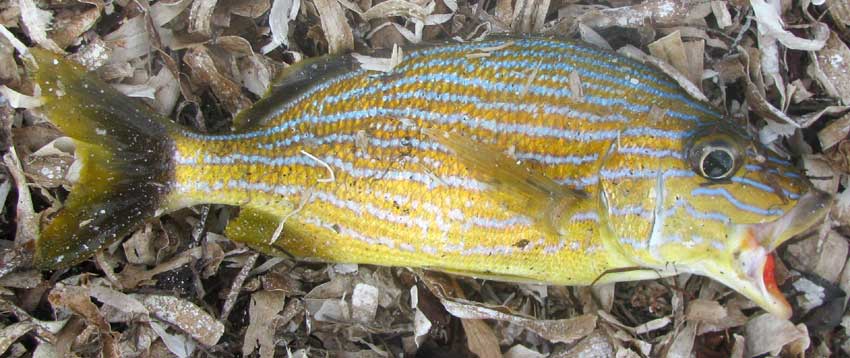Excerpts from Jim Conrad's
Naturalist Newsletter

from the July 31, 2011 Newsletter issued from Mayan Beach Garden Inn 20 kms north of Mahahual; Caribbean coastal beach and mangroves, ~N18.89°, ~W87.64°, Quintana Roo state, MÉXICO
GRUNT IN THE GRASS
Some visitors and I on a beach walk came upon three young Mexican men fishing. They'd waded out about fifty feet to where the water was waist deep and were tossing their lines into spots where they thought there'd be fish. They used hooks, lines and sinkers, but no poles or rods and reels. With their right hands they'd toss lines wrapped around their left hands. As we approached, one man was coming ashore with a fighting fish on his line. You can see his 10-inch-long catch (25cm) lying in wave-deposited Turtlegrass above.
Back at Marcia's little visitor library, in Humann and DeLoach's Reef Fish Identification: Florida, Caribbean, Bahamas, it was easy to get the name of such a boldly patterned, brightly colored fish. It was the Bluestriped Grunt, HAEMULON SCIURUS. Several species are more or less this color and also bear slender, longitudinal stripes, but this one also has dark tail and rear dorsal fins.
The species is described as common in waters around Florida, the Bahamas, and throughout the Caribbean, and uncommon as far north as South Carolina. The book says that Bluestriped Grunts congregate in small to midsized schools near protective reefs, especially drop-offs, though ours was caught well away from the reef, among big beds of Turtlegrass. Elsewhere I read that grunts in general are especially common around reefs next to large expanses of grass beds and sand flats, which is exactly what we have here.
Why are grunts called grunts? It's because of the sound they produce when their teeth grind deep within their throats, amplified by their air bladder.
I always regret seeing fishermen lay their catches on dry land where the fish slowly die, as was the case with this fish. When I was a kid I was told that fish can't feel anything, but eventually I used my own brain to see that they are as sensitive to touch and pain as any other complex living organism, maybe more so than most. I don't like presenting the picture of a slowly dying fish, but maybe there's value in the picture reminding us what lovely creatures are out there, all the time, living their own beautiful lives.